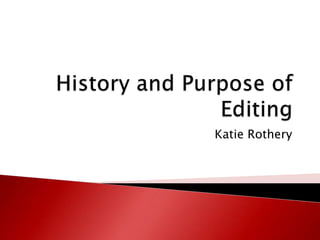
History of editing
- 2. In 1895 the Lumiere Brothers invented Cinematographe. Cinematographe was a three in one device that recorded, captured and projected motion picture. http://www.youtube.com/watch?v=4nj0vEO4Q6s
- 3. Although the Lumiere Brothers had a great invention, Edwin S. Porter came along and showed that film didn’t have to be one long still in 1901. Edwin S. Porter also used footage to tell a different story unrelated to what the footage originally was meant to portray. http://www.youtube.com/watch?v=p4C0gJ7BnLc
- 4. In 1908 D.W Griffiths film “'For Love of Gold” featured the first ever continuity cut when a scene cut... Griffiths then realised that emotions could also be portrayed through different camera angles and pace of editing and it wasn’t all down to the actors. Griffiths was given credit for the narrative of a film, the production of the first American feature film and the discovery of the close up. This is his first directed one reel film... http://www.youtube.com/watch?v=cYQCTEYjYDA
- 5. The Birth of a Nation is based on the Novel “The Clansman” -1915 The film included camera techniques such as panoramic long shots, iris effect, still shots, cross cutting and panning shots. There techniques are widely used today to create films. http://www.youtube.com/watch?v=FDiQWsENgnk&feature=watch- now-button&wide=1 The use of sound allowed the film to be more interested and to make the audience feel more involved. http://www.youtube.com/watch?v=k57rt58vUYw
- 6. Discovery of the Kuleshov Effect was Soviet director and film theorist Lev Kuleshov. The Kuleshov effect was a montage effect on a film which Lev Kuleshov believed the audience would respond to more. Eisenstein and Dziga Vertov demonstrated the potentials of montage. Eisenstein’s 1925 Battleship Potemkin-Montage http://www.youtube.com/watch?v=jebW5-G2HTs Eisenstein said that film montage could create ideas different from a average film.
- 7. Analogue Editing- Analogue editing was used before editing on a computer. The film negative when completed was cut down and pasted into an order. It then went through a machine such as Moviola or K.E.M Digital Editing- Editing with a computer is much faster and more efficient for film. Many different programs can be used such as Final Cut Pro, Adobe Premier and iMovie. Footage is put onto the timeline and is then cut and pasted into an order and then the effects are added.
- 8. Editing has allowed films now a days to grow and become more interesting for audiences through aspects such as camera angles, narrative, actors and many more. As we can see D.W Griffiths film “House of Darkness” (http://www.youtube.com/watch?v=g_5YSdqCKaE) did use some aspects of editing and fades but compared to the 21st Century films have changed a lot due to the type of software that we have and the type of technology and the knowledge. Although films nowadays such as Batman use lots of special effects, camera angles and many more to create a film that the audience want. http://www.youtube.com/watch?v=g8evyE9TuYk
- 9. The purpose of editing allows firstly the film to flow so the audience are interested by what they’re seeing on the screen. It also allows there to be a narrative of time with the use of camera angles, pace and narrative structure. When editing was being tried and tested in the early 1900’s the film producers and directors realised they need to create their films in a different way to get people to enjoy them. Manipulate Space and Time http://www.youtube.com/watch?v=XjPb3ziyYYo
- 10. Techniques of editing include transitions such as cuts, jump cuts, fades and washout. All these have an important role within editing as the cuts etc allow the film to move at a quick pace in order for the film to stay interesting to the audience. Cut: http://www.youtube.com/watch?v=wCbDUREBwUg Motivated Cut: JumpCut:http://www.youtube.com/watch?v=WrdCC9ZHhwY&feature= player_embedded#!
- 11. Editing Rhythm is techniques such as cross cutting and cross cutting to music. In D.W Griffiths film “The Birth of a Nation” cross cutting is used to show two types of action happening at one time http://www.youtube.com/watch?v=k57rt58vUYw
- 12. Such as inserts, cutaways, point of view and reverse shot. See this point of view shot that appears in 1947 film “Lady in the Lake” POV Shot: http://www.youtube.com/watch?v=Zzdl-js_mQ4 Reverse Shot: http://www.youtube.com/watch?v=QLkUHZ1qips Inserts: http://www.youtube.com/watch?v=mwQcypL2Wz4
- 14. Editing to withhold or provides information allows the audience to be more involved in the film. It makes the audience want to watch to either piece together the information that has been provided or find out the information that is being withheld to get the bigger picture of the story. http://www.youtube.com/watch?v=Qj0JDnQIZf0&feature=player_em bedded
- 15. Following the action- http://www.youtube.com/watch?v=OqSg7WO4tT4 Slow Motion shothttp://www.youtube.com/watch?feature=player_detailpage&v= KNrSNcaYiZg#t=69s Flashback-http://www.youtube.com/watch?v=435mkg6_eGQ Wild track- http://www.youtube.com/watch?v=PZ2QFmJ7h0A Establishing Shot- http://www.youtube.com/watch?v=Sqj7pNAHnWg